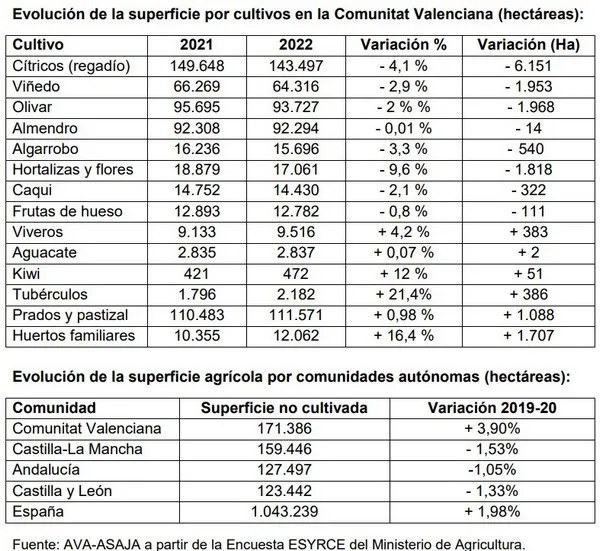According to a study by the Valencian Association of Producers (AVA-ASAJA) based on the Esyrce survey of the Ministry of Agriculture, in 2022 the agricultural area of the Valencian Community that was abandoned increased by 6,437 hectares, i.e. 3.9% more than in the previous year, setting a historical record of a total of 171,386 abandoned hectares.
In Spain, as a whole, the number of lands that were no longer cultivated increased by 2% over the previous year, raising the overall calculation to 1,043,239 hectares. AVA-ASAJA concluded that one in three hectares that were abandoned in 2022 were located in the Valencian Community, which more prominently consolidates its leading position in abandoned agricultural land at the national level and very possibly in Europe. Not surprisingly, other autonomous communities with greater agricultural extension have recovered arable land: Castilla-La Mancha 1.53% (159,446 vacant hectares), Castilla y León 1.33% (123,442 hectares), and Andalusia 1.05% (127,497 hectares).
All the main Valencian crops experienced a significant decrease in the surface. Citrus fruits lost 6,151 hectares, i.e. -4.1% compared to 2021, going from 149,648 to 143,497 irrigated hectares; the area devoted to vegetables and flowers fell by 9.6%, khaki by 2.1% and stone fruits by 0.8%. In contrast, there was an increase in the area devoted to kiwi (+12%) and avocado (+0.07%). There was an outstanding increase in family orchards, mainly dedicated to self-consumption, which after increasing by 16.4% in the last year exceeded 12,062 hectares.

In view of these new data that corroborate the crisis of profitability of Valencian producers, AVA-ASAJA reiterates the urgency of adopting a roadmap that is agreed on by all political parties and the sector so as to guarantee the economic stability of the agricultural activity that allows reactivating the generational relay and recovering vacant fields.
“The political class can no longer wait to react urgently and effectively. We are leaders in uncultivated lands, the aging of the agrarian population, and the lack of incorporation of young people. More and more environmental requirements are being imposed on us, while imports with a greater carbon footprint and phytosanitary residues are being allowed to enter. We are banned from using more and more plant medicines, but they don't demand that producers from abroad ban those products. Fewer inspections are being carried out and commercial abuses are not being investigated. If things don't change, this will affect more than producers. It will affect society as a whole, putting at risk its food self-sufficiency, care for the territory, and the fight against climate change,” the president of AVA-ASAJA, Cristobal Aguado, stressed.
For more information:
AVA-ASAJA
info@avaasaja.org
www.avaasaja.org
